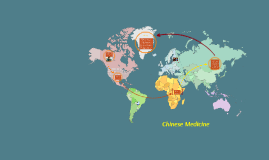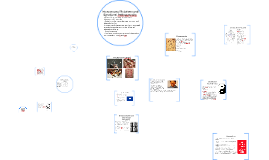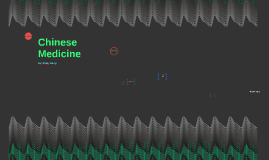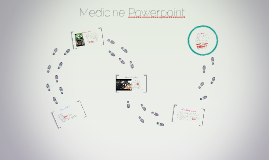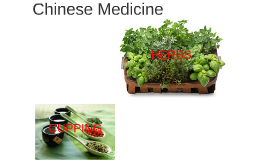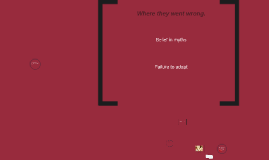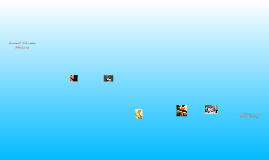Chinese Medicine:
Transcript: Origins of TCM Prevention Interpersonal Relations and Emotional Pathogenecity Treatments Cont'd Chinese Medicine: A Sociocultural perspective on Emotional Pathogenicity Max Marlowe Traditional Foundations Treatments - Unlike Western medicine, many of the traditional treatments are not based on anatomical knowledge, but on knowledge of the relationship of change between the Zang Organs. -All emotions are filtered through the heart. - Problems are caused by Qi stagnations. -Acupuncture -Cupping -Counter-Emotional Therapy: -Herbs: -Five Flavors Work Cited -First documented in the Warring States Period. In Conclusion -Wuxing: Characteristic activities of the five phases: Wood, Earth, Water, Metal, Fire, through cycles of production and restraint -Not elemental in the way we think, but in regards to the process of change. -Associated with the five Zang organs, and there complementary Fu organs. -Emotions also assigned to specific elemental processes, and thus follow the same logical pattern. 5 Heavenly Virtues and Seven Emotions -First writing: The Inner Classic of the Yellow Emperor -All emotions are seen to arise out of interpersonal interaction -There is no distinction between external and internal stimulus -Interpersonal interactions are highly regulated in order to maintained in order to benefit internal conditions. -"Face Economy" -Confucian rules of interpersonal relationship, self cultivation, and li and ren. - Very high mortality in China after the establishment of the PRC, and very few resources -Health conference made the "Walking on Two Legs Policy", which made Western and Chinese medicine come together to fight the health crisis in China - The core of the Chinese medical tradition is based on Daoism, Yin and Yang, and the five elements -Energy Dynamics -Qi and Shen -Qi: The natural life force of all living things. Flows through body meridians in specific patterns, with a finely tuned balance -Shen: Is the spirit and the mind. TCM seeks to cure on the Shen level. "If the spirit is at peace, the heart is in harmony; if the spirit becomes aggravated the heart wavers, and when the heart wavers the body becomes injured; if one needs to heal the physical body, one needs to regulate the spirit first" - Liu Zhou Bond, Michael Harris. "Emotions and Their Expression in Chinese Culture." Journal of Nonverbal Behavior. 17.4 (1993): 245-262. Print. Fruehauf, Heiner. "All Disease Comes From the Heart: The Pivotal Role of the Emotions in Classical Chinese Medicine." (2006): n. page. Web. 3 Apr. 2014. <classicalchinesemedicine.org>. Maimon, Yair. "Seven Emotions and their Effect on Qi and Shen." (2007): n. page. Print. Marks, Joel, and Roger T. Ames. Emotions in Asian Thought. New York: State University of New York Press, 1995. Print. Tsai, Jeanne L., and Robert W. Levenson. "Cultural Influences on Emotional Responding: Chinese American and European American Dating Couples During Interpersonal Conflict." Journal of Cross- Cultural Psychology. 28.5 (1997): 600-625. Print. Zhang, Yanhua. Transforming Emotions with Chinese Medicine. New York: State University of New York Press, 2007. Print. Republican China - The Five Natures ( Compassion, Propriety, Integrity, Selfishness, and Wisdom) are gifts from heaven, and one's born nature. - The Seven emotions are secondary functions of the Five Natures -They are in dynamic movement for balance, anything which has the more of the Five Natures is more Yang, and anything which contains more of the Seven emotions is Yin. -Transformative in nature -The Five Natures allow the Zang organs to exist in a pure state, and the Seven emotions cause imbalance and chaos, thus leading to disease. -One cannot eliminate emotions, but one should strive to control them. - Concept of Du, which represents degree or quantity - Value in moderation. Wariness of any expressive extreme. -Confucian: "Correcting the mind and training the Temperament." -Carries into day-to-day life. Studies on intensity and duration of emotion in Chinese society. -Intense shows of emotion have ability to make one lose face (social shaming), and throw ones internal rhythm out of sync, leading to pathogenic effects. -The Cultural revolution saw increased technology in the Chinese medical field, and partial integration with Western Medicine. Five Elements and TCM -Chinese Medicine is sculpted by its traditional foundations -Lack of distinction between internal and external influence elicits behavioral modifications to preserve health and social status. TCM in Imperial China -Flourished in the Song and Tang Dynasty -Mainly in response to treating the emperor and his family. -In Song, first medical colleges opened, though they actually trained few practitioners. Most were trained through apprenticeship. -Philosophies drawn from Daoism, Five Elements, Yin and Yang, and Confucianism PRC and Communist Revolution -The Opium war exposed the inadequacies of a system based solely on tradition in the face of Modern Western cultures






